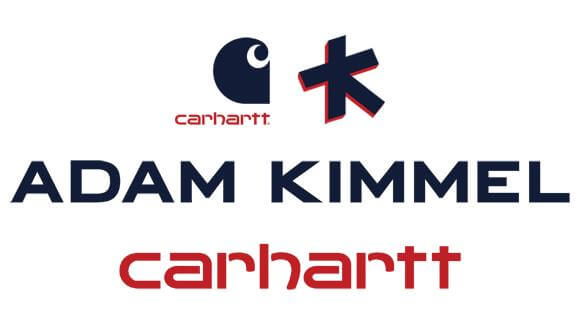In 2011, Adam Kimmel’s first Carhartt collection debuted at Barneys New York, select other retailers nationwide, and internationally. Known for his Italian-style tailoring and relentlessly luxurious minimalist aesthetic, it seemed like Kimmel took a bit of a detour with this partnership with the stolid workwear company.
Carhartt, Inc., has offered affordable, well-made, heavy-duty pieces for more than 130 years. But what seemed like a detour was more of a full circle: Kimmel remembered wearing and loving Carhartt since childhood. So he easily found the common denominators between his high-fashion AK menswear line and what he called the “American heritage” brand: integrity, quality, and a thoroughly masculine edge.
Jay Bell, then Barneys’ vice president and merchandise manager, made the initial overtures that resulted in the collaboration. It was Bell who first saw the creative possibilities and connected Carhartt and Kimmel as a merchandising win for Barneys, as well.
Romancing an American heritage brand
This first collaboration with another clothing brand gave Kimmel, as he put it, an opportunity to “expand my business in a romantic way.” It became one in a series of thoughtfully implemented creative endeavors highlighting cultural influencers—for example, Snoop Dogg, Beat-era art magazine Semina, and “artificial realist” artist George Condo—whose distinctive styles and immediately recognizable viewpoints vibed with Kimmel’s own.
For Carhartt, this very special partnership signaled its first stateside venture into designer clothes after pairing with noted European brands. Kimmel put a lot of effort into showing Carhartt they were dealing with a fan with total respect for their product, someone whom they could trust when putting their brand in his hands.
For his Carhartt launch, Adam Kimmel created more than two dozen pieces in classic, comfortable fabrics like denim, cotton twill, moleskin, and flannel. He offered a quilted moleskin jacket, moleskin pants, a canvas artist’s coat lined with brushed cotton, and other distinctive outerwear items. There were shirts constructed from denim or flannel, and the color palette centered on the designer’s favored neutrals, as well as indigo and royal blue.
Another of the stylistic innovations for Carhartt was to switch up its classic wave-shaped logo from crimson and gold to blue and red.
Throughout, the designer focused on sleekening the cut and softening the texture of the fabrics he used. He transported the basic ethos of his AK brand, whose pieces were fashioned in Italy from the finest Italian-made fabrics, to Carhartt’s facilities in the United States.
“Honest value for an honest dollar”
These pieces mirrored the workwear themes that distinguished most of Kimmel’s collections under his own brand, but featured affordable price points starting from about $70.
He had always been impressed, Kimmel told an interviewer from Dazed Digital, with Carhartt’s “quality and durability.” The company’s thoughtfully designed extra touches, including reinforced riveting, disaster-resistant fabrics, and heavy-duty threads, extend the life and wearability of their heavy-rotation garments for years. A dozen years after his first Carhartt collection appeared, the elegantly sturdy pieces are holding their value on upscale resale clothing sites like TheRealReal.
In 1889, in Dearborn, Michigan, Hamilton Carhartt founded the company that now bears his name. His motto: “Honest value for an honest dollar.” He’d started out in furniture, but a conversation with a railroad engineer led Carhartt to realize there was a market for the kind of tough, durable work clothing that railway and other workers needed. From half a dozen staff and two sewing machines, Carhartt expanded his business thanks to the industrial build-out, in steam and steel, of a growing nation. He also dressed farmers and ranchers—anyone who needed sturdy, element-resistant pieces for working outdoors.
The very bearable lightness of being
In his second collaboration with Carhartt, Kimmel’s quirky humor—and that of his model, photographer Ari Marcopoulos—leapt off the page that recorded their “A Day in the Park” photo shoot.
Kimmel constructed these designs around the classic looks of park rangers and state troopers—two public service jobs for which he holds a lot of respect. After stopping by Kimmel’s office and putting on the iconic ranger hat he saw there, Marcopoulos became one in a long line of Kimmel friends and creative influences to serve as muse. The dark green flight coat Kimmel shaped from duck canvas fabric fit Marcopoulos with the designer’s trademark fine tailoring.
While he designed his initial Carhartt collection for Fall/Winter 2011, Kimmel was able to bring a more delicate touch to the second edition for Spring/Summer 2012. He lightened up the fabrics and gave the whole a more refined, elevated touch. To create the backdrop for the clothing, he brought in Paintallica, the “gutsy and tough” artists’ collective whose carvings adorned display windows at Barneys, among other venues. It’s that gutsy toughness that Kimmel wanted to define that season’s pieces.
Today’s Carhartt brand, still based outside of Detroit and still family-owned, continues to signify value, fitness for purpose, and style. And Adam Kimmel’s Carhartt collection—like each of his runway collections and artistic collaborations—continues to inspire passion in new fans, thanks to his precise eye for how to best infuse fashion into function.
